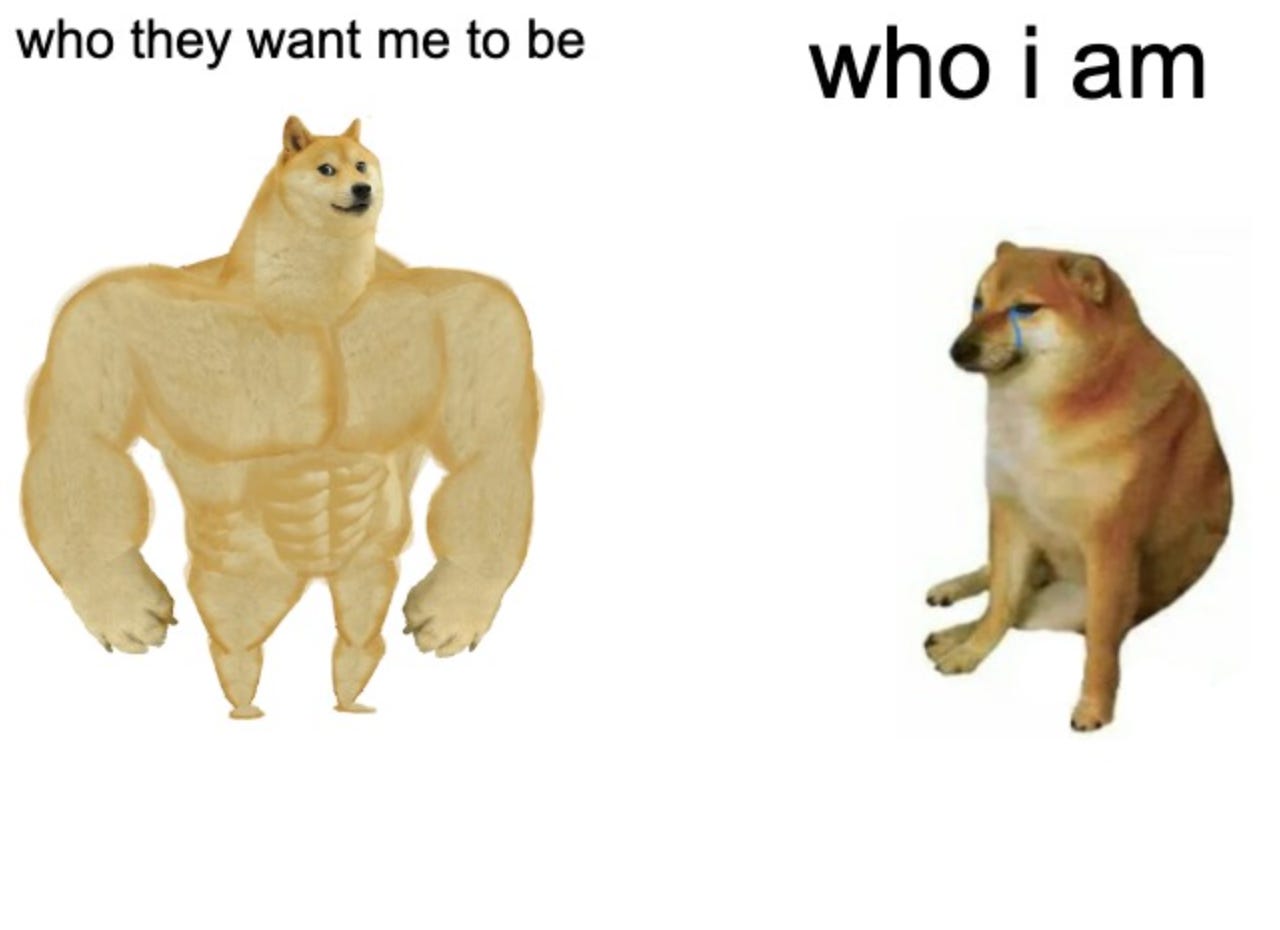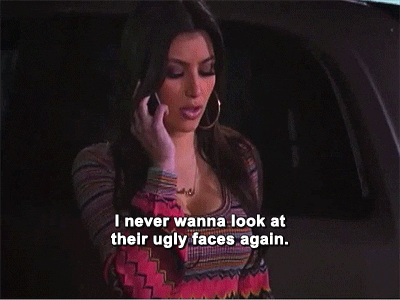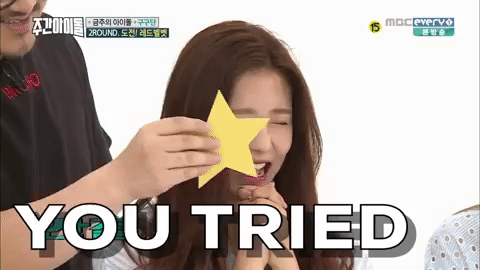Who You Are vs Who They Want You to Be
If there were a pros and cons list of being human, the ability to always be yourself no matter who you are speaking to or what situation you are in is basically a superpower, let alone a pro. How do the people who possess this quality do it?
I’m not saying that I think I am a fake person, but I guess I am reactive. If everyone in a group is being loud, I’ll be quiet. If someone has a story they are desperate to tell or advice they would like to hear, I’ll listen and give it. But at what point is feeling the needs of others, and reacting to them, subjugating yourself? In every situation, there will be moments when you act from a place of who you are, or who “they” want or need you to be. Entire relationships can be forged on versions of you that your partner, friends, colleagues, and family members need you to be, instead of who you truly are. Sometimes, or often, we might not know exactly who we are, but we do know who we are not, or who we don’t want to be.
Homecoming Queen
Image from The Virgin Suicides
Popularity isn’t as transparent as it may at first glance appear. Sure, there are the obvious types of popularity, such as being school captain or homecoming king or queen. But as you grow up and out of the early social structures that taught us the meaning of popularity, and move into the world of being an adult, you realize that it’s also about being the most admired and liked in your group of friends, the most liked in the family, in your job, in your volunteer group. There’s being popular in the Taylor Swift kind of way, and then there’s also being popular in the Daria kind of way.
While both couldn’t be further from each other (especially given that one, I’m not saying which one, is a fictional animated character), they are more similar than we may think, as each, in their own way, is the most popular within their particular circle or fan base.
Share, Like, and Subscribe
In a galaxy light-years away, where content creators were once magazine editors—the Anna Wintour (Vogue editor), Shane Smith (Vice co-founder), and Ashley Heath’s (Pop magazine founder). Now, it’s not about them anymore; it’s about us. Or is it? While the field has definitely become bigger and the game maybe more interesting, the goalposts also seem to have gotten smaller.
Take the Kardashians as an example. Whether you love them or hate them, it’s not the question; it’s that you have definitely heard of them. The Kardashians as a family unit have amassed a total of over 1.367 billion Instagram followers. If you try to picture a room that holds around 100 people in it, you will probably be able to just about imagine it, in that it’s not a completely intangible number for our brains to take in. But once that number begins to rise over 150, it’s standby mode on.
This effect is known as Dunbar's number. Robin Dunbar, a British anthropologist, proposed that there is a cognitive limit to the number of individuals with whom one can maintain stable social relationships. This limit is commonly estimated to be around 150, and is often referred to as Dunbar's number.
While Dunbar's number specifically refers to social relationships, it has been extended to various aspects of cognitive processing and storytelling. The idea is that people may struggle to grasp or connect with a story that involves a large number of characters or elements beyond a certain threshold. This is because our cognitive capacity for tracking and understanding complex social networks or intricate storylines is limited.
So, if this is true and our minds begin to fizzle and melt at the thought of more than 150 people, then thinking of the Kardashians with their 1.367 billion Instagram followers should of just sent us into anaphylactic shock.
Keeping Up With the Kardashians
"Keeping Up with the Kardashians" was a reality television series that aired from 2007- 2021 on the E! cable network. In 2022, it regrouped, re-branded, and came back on DisneyPlus as just the "Kardashians" - a true “Madonna” moment for them. If you are unfamiliar with the premise of the show, it’s a reality show that follows the lives of the Kardashian-Jenner family, a high-profile and influential family in the entertainment industry. The main cast included Kris Jenner (the matriarch), her children Kourtney, Kim, Khloé, and Rob Kardashian, as well as Kendall, Kylie, and Bruce Jenner (Bruce, who is now known as Caitlyn Jenner after their transition).
The series provided a glimpse into the personal and professional lives of the family members, putting their relationships, business ventures, and various aspects of their day-to-day activities on display. The Kardashians became known for their glamorous lifestyles, family feuds, fashion, and frequent appearances in the media. The show also featured guest appearances from other celebrities and documented the family's experiences, struggles, and triumphs over the years.
The show also played a significant role in popularizing the concept of reality television and contributed to the family's widespread fame and success in various industries, including fashion, beauty, and social media.
Today, when one of the most popular Kardashians, Kim, is asked to define what she does for a living, she struggles to answer the question. Possibly because what Kim, along with the other Kardashians has managed to do is make an empire from being a particular version of herself that others need and want her to be—i.e., welcome to the Reality TV Star era.
Social Media and the Reality TV Star
The rise of reality TV, saw shows like The Simple Life,
Pictured Paris Hilton and Nicole Richie
Keeping Up with the Kardashians, and MTV’s The Real World, took the consumer need-base for content that centered around people sharing their everyday lives, laid the foundation, and then, with the help of social media channels like YouTube and TikTok, catapulted the genre into a whole new stratosphere altogether. Since then audience desire to watch ordinary people doing ordinary things has spiked so much that social media channels have become oversaturated with user generated content.
If you’re not down with this kind of marketing lingo, don’t worry, I got you. User-generated content (UGC) refers to any form of content, such as text, images, videos, reviews, etc., that is created and shared online by users of a platform or website, rather than by the organization or entity that owns the platform. So the majority of content that is on social media platforms like Instagram, TikTok etc. is user generated. Over time popularity and views amongst content creators on these platforms has become a fight to the death, with the winners being the ones who are the most tech-savvy, who know how to engage with their audience, ask questions, encourage them to leave comments, and importantly be vulnerable. There has to be at least one breakdown/cry video amongst all the perfection.
That’s the on camera answer, the off camera one is, it’s the ones who know how to invest their money into search ads, keyword bids, SEO, sponsored content, have figured out how the algorithm works and what stories will be boosted, collaborations, consistency of posting, giveaways, and performance analytics—aka making new content based on what performed best for you in the past.
An Idea is Born
Everyone, at some point, starts with an idea, whether that be 'I’m going to make a YouTube channel, an album, a blog,’ or any other number of things. In the beginning, the formation of the initial idea is usually based on what you enjoy, what you yourself need or would want to see or hear more of. Sometimes, ideas are also formed out of what is seen to be popular or trending and then attempting to somehow integrate or monetize on that with your own work. But when it comes to the individual creator, it’s usually the former rather than the latter that wins, at least in the beginning. So at what point does the desire for popularity, visibility, and growth begin to be all like, ‘I’m over this supporting character role, honey, I wanna be the lead!’?
I Don’t Want to Be Popular, I Just Want to Be Seen
When we first started MAI back in 2018, the idea came from our desire to build a creative platform that would serve as a place for creatives to be able to come and be inspired. At the time, all the magazines that we were following or liked from Vice to NOWNESS, I-D, and Friends of Friends, were featuring creatives who had already attained a decent amount of success (i.e., already had a social media following in the double or triple digits) and lived in everything from boho-chic to just pure designer chic homes. While watching and reading about the stories of already successful creatives was/is aspirational, it ultimately wasn’t relatable. At that time there were also barely any magazines out there that were colorful and eclectic or didn’t have a print version. Ours was all of the above. The fact that we were even calling ourselves a magazine was partly a joke, and is still a bit of a running gag because we were a digital publication with no plans of ever being printed. Plus, we were just two people. Myself, a video producer, editor and photographer by day, and my co-founder, a musician, designer, and part-time Lieferando employee.
When we came up with ideas for content and wrote stories or made videos, we definitely didn’t think about what performed best previously or how to write articles full of search-optimized keywords and backlinks. In some ways, I still say this with a twinkle of pride because screw the need to be everything these days: tech-savvy, creative, business-minded, and the list goes on. But when the gig was up and Covid-19 hit, our freelance side hustles dried up, and we couldn’t afford to run MAI anymore. I take a moment to look back now at how we began, and all I can think is WOWWW, we were so naive.
Am I a Risk Taker or Am I Naive
There’s some bits of advice that you will receive in your life that will become unforgettable over time. A university professor once told me when I rushed into a meeting at his office—I was trying to sign up for his class and I barely made it in on time. I remember I was running late because I had slept through my alarm and got lost on the university grounds. However, upon my arrival, he shared a thought that has stayed with me ever since: “You know, the lucky ones in life are those who take risks."
the lucky ones in life are those who take risks.
At first, I thought he was being sarcastic. Back in those days, I in no way considered myself a lucky person. As an immigrant kid (from an Eastern European background, for reference), the glass always felt half empty. I was also 20 at the time, meaning that the majority of my “risk-taking” was emanating from my inner self-saboteur, procrastinator, and latent rebellious teen self (as my psychologist would have said) rather than true risk-taker. However, in the end, I did get into the class, and while I can’t even recall anymore which class it was (ironically, it may have been ‘An Introduction to Pop Culture”) or the professor’s name, this statement has somehow managed to stay with me.
Who Am I
It was quite some time after coming up with the name MAI, which is an acronym for Music, Art, and Illustration, that I would recognize that MAI is I AM backward.
Figuring out who I am and staying true to that and aligning those values to MAI as well is all I/we ever really wanted. In an era where social media is King, taking the no rules and no plans wild approach, might still seem tempting to my inner rebellious teen self but in hindsight also naive at best and self-sabotage at worst.
The reason why the Emma Chamberlain’s and even, to an extent, the Kardashians are as popular as they have become is because they started a movement towards vulnerability and broke down the wall of audience/viewer interaction. Of course, at some point it became a muddled mess with what it means to be female in our society and the male gaze, fame, popularity, mon-ay, sponsorship deals, etc., etc. But doing you, and being open about it, and not being afraid to share that even if it’s just to one person. That’s what it’s about and it’s who I/we want to be.
So in the following weeks, in our attempt to stay true to ourselves, we will be covering topics that are close to our chests, because while nerve-racking at times (a lot of the times), I won’t lie, it’s what I feel that I want and need more of in my own life right now. During this process too, we hope to open up MAI as a platform where readers can anonymously submit their own experiences with us, if they want to. Because at the end of the day we see MAI as a community, one where we want to nurture as a safe space for creatives to be able share their humbling stories of failure, tears, success and everything else in between.
So from now and in between.
Love, M.
Blog written by: Marijana Jocic











